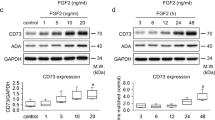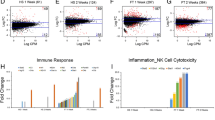Abstract
The Wobbler mouse, a model of amyotrophic lateral sclerosis (ALS), presents motorneuron degeneration and pronounced astrogliosis in the spinal cord. We have studied factors controlling astrocyte proliferation in cultures derived from Wobbler and control mice spinal cord. Basal rate of [3H]thymidine incorporation was 15 times lower in Wobbler astrocytes. While in control cultured cells interleukin-1α (IL-1) and corticosterone (CORT) significantly increased proliferation, both agents were inactive in Wobbler astrocytes. The lack of response to CORT was not due to the absence of glucocorticoid receptors, because similar receptor amounts were found in Wobbler and control astrocytes. In contrast to IL-1 and CORT, transforming growth factor-β1 (TGF-β1) substantially increased proliferation of Wobbler astrocytes but not of control cells. Differences in response to TGF-β1 were also obtained by measuring glial fibrillary acidic protein (GFAP) immunoreaction intensity, which was substantially higher in Wobbler astrocytes. Thus, abnormal responses to different mitogens characterized Wobbler astrocytes in culture. We suggest that TGF-β1 may play a role in the reactive gliosis and GFAP hyperexpression found in the degenerating spinal cord of this model of ALS.
Similar content being viewed by others
REFERENCES
Schiffer, D., Cordera, S., Cavalla, P., and Migheli, A. 1996. Reactive astrogliosis of the spinal cord in amyotrophic lateral sclerosis. J. Neurol. Sci. 139:(Suppl.) 27–33.
Murayama, S., Inoue, K., Kawakami, H., Bouldin, T. W., and Suzuki, K. 1991. A unique patter of astrocytosis in the primary motor area in amyotrophic lateral sclerosis. Acta Neuropathol. 82:456–461.
Nagy, D., Kato, T., and Kushner, P. D. 1994. Reactive astrocytes are widespread in the cortical gray matter of amyotrophic lateral sclerosis. J. Neurosci. Res. 38:336–347.
O'Reilly, S. A., Roedica, J., Nagy, D., Hallewell, R. A., Alderson, K., Marklund, S. L., Kuby, J., and Kushner, P. D., 1995. Motor neuron-astrocyte interactions and levels of Cu,Zn superoxide dismutase in sporadic amyotrophic lateral sclerosis. Exp. Neurol. 131:203–210.
Hall, E. D., Osstveen, J. A., and Gurney, M. E. 1998. Relationship of microglial and astrocytic activation to disease onset ad progression in a transgenic model of familial ALS. Glia 23: 249–256.
Fujita, K., Yamauchi, M., Matsui, T., titani, K., Takahashi, H., Kato, T., Isomura, G., Ando, M., and Nagata, Y. 1998. Increase of glial fibrillary acidic protein fragments in the spinal cord of motor neuron degeneration mutant mouse. Brain Res. 785: 31–40.
Laage, S., Zobel, G., and Jockusch, H. 1988. Astrocyte overgrowth in the brain stem and spinal cord of mice affected by spinal atrophy, wobbler. Devel. Neurosci. 10:190–198.
Gonzalez Deniselle, M. C., Gonzalez, S., Piroli, G., Lima, A., and De Nicola, A. F. 1996. The 21-aminosteroid U-74389F increases the number of glial fibrillary acidid protein-expressing astrocytes in the spinal cord of wobbler mice. Cell Mol. Neurobiol. 16:61–72.
Gonzalez Deniselle, M. C., Gonzalez, S., Piroli, G., Ferrini, M., Lima, A., and De Nicola, A. F., 1997. Glucocorticoid receptors and actions in the spinal cord of the wobbler mouse, a model for amyotrophic lateral sclerosis. J. Steroid Biochem. and Mol. Biol. 60:205–213.
Hantaz-Ambroise, D., Cambier, D., Ait-Ikhlef, A., Parvy, Ph., Murawsky, M., and Rieger, F. 1995. Excess extracellular and low intracellular glutamate in poorly differentiating wobbler astrocytes and astrocyte recovery in glutamine-depleted culture medium. J.Neurochem. 65:1199–1204.
Giulian, D., Woodward, J., Young, D. G., Krebs, J. F., ad Lachman, L. B. 1988. Interleukin-1 injected into mammalian brain stimulates astrogliosis and neovascularization. J. Neurosci. 8:2485–2490.
Laping, N. J., Teter, B., Nichols, N. R., Rozovsky, I., and Finch, C. E. 1994. Glial fibrillary acidic protein: regulation by hormones, cytokines, and growth factors. Brain Pathol. 1:259–275.
Merril, J. E. 1991. Effects of interleukin-1 and tumor necrosis factor-α on astrocytes, microglia, oligodendrocytes, and glial precursors in vitro. Dev. Neurosci. 13:130–137.
Gagelin, C., Pierre, M., Gavaret, J. M., and Toru-Delbauffle, D. 1995. Rapid TGF beta 1 effects on actin cytoskeleton of astrocytes: comparison with other factors and implications for cell motility. Glia 13:283–293.
Morgan, T. E., Laping, N. J., Rozovsky, I., Oda, T., Hogan, T. H., Finch, C. E., and Pasinetti, G. M. 1995. Clusterin expression by astrocytes is influenced by transforming growth factor beta 1 and heterotypic cell interactions. J. neuroimmunol. 58: 101–110.
Da Cunha, A., Jefferson, J. A., Jackson, R. W., and Vitkovic, L. 1993. Glial cell-specific mechanisms of TGF-β1 induction by IL-1 in cerebral cortex. J. Neuroimmunol. 42:71–86.
Yung, K. K. L., Tang, F., and Vacca-Galloway, L. L. 1992. Changes of neuropeptides in spinal cord and brain stem of Wobbler mouse at different stages of motorneuron disease. Neuroscience 50:209–222.
Schillaci, R., Brocardo, M. G., and Roldan, A. G. 1995. Cooperative effect between insulin-like growth factor-1 and interleukin-2 on DNA synthesis and interleukin-2-receptor-α chain expression in human lymphocytes. Immunol. & Cell Biol. 73:340–345.
Ferrini, M., Lima, A., and De Nicola, A. F. 1995. Estradiol abolishes autologous regulation of glucocorticoid receptors in brain. Life Sci. 57:2403–2412.
Roldan, A., Gogg, S., Ferrini, M., Schillaci, R., De Nicola, A. F. 1997. Glucocorticoid regulation of in vitro astrocyte phagocytosis. Biocell 21:83–89.
McGimsey, W. C., Cidlowski, J. A., Stumpf, W. E., Sar, M. 1991. Immunocytochemical localization of the glucocorticoid receptor in rat brain, pituitary, liver, and thymus with two new polyclonal antipeptide antibodies. Endocrinology 129:3064–3072.
O'Callaghan, J. P., Brinton, R. E., and McEwen, B. S. 1991. Glucocorticoids regulate the synthesis of glial fibrillary acidic protein in intact and adrenalectomized rats but do ot affect its expression following brain injury. J. Neurochem. 57:860–869.
Rozovsky, I., Laping, N. J., Krohn, K., Teter, B., O'Callaghan, J. P., and Finch, C. E. 1995. Transcriptional regulation of glial fibrillary acidic protein by corticosterone in rat astrocytes in vitro is influenced by the duration of time in culture and by astrocyte-neuron interactions. Endocrinology. 136:2066–20073.
Kopmels, B., Wollman, E. E., Guastavino, J. M., Delhang-Bouchaud, N., Fradelizi, D., and Mariani, J. 1990. Interleukin-1 hyperproduction by in vitro activated peripheral macrophages from cerebellar mutant mice. J.Neurochem. 55:1980–1985.
Ikeda, K., Kinoshita, M., Tagaya, N., Shiojima, T., Taga, T., Yasukawa, K., Suzuki, H., and Okano, A. 1996. Coadministration of interleukin-6 (IL-6) and soluble IL-6 receptor delays progression of wobbler mouse motor neuron disease. Brain Res. 736:91–97.
Mattson, M. P., Barger, S. W., Furukawa, K., Bruce, A. J., Wyss-Coray, T., Mark, R. J., and Mucke, L. 1997. Cellular signaling roles of TGFβ, TNFα and βAPP in brain injury responses and Alzheimer's disease. Brain Res. Rev. 23:47–61.
Kreutzberg, G. W. 1996. Microglia: a sensor for pathological events in the CNS. TINS 19:312–318.
Junier M. P., Coulpier, M., Le Forestier, N., Cadusseau, J., Suzuki, F., Peschansi, M., and Dreyfus, P. A. 1994. Transforming growth factor alpha (TGF α) expression in degenerating motorneurons of the murine mutant wobbler: a neuronal signal for astrogliosis?. J. Neurosci. 14:4206–4216.
McKeon, R. J., Schreiber, R. C., Rudge, J. S., and Silver, J. 1991. Reduction of neurite outgrowth in a model of glial scarring following CNS injury is correlated with the expression of inhibitory molecules on reactive astrocytes. J. Neurosci. 11:3398–3411.
Ridet, J. L., Malhotra, S. K., Privat, A., and Gage, F. H. 1997. Reactive astrocytes: cellular and molecular cues to biological function. TINS 20:570–577.
Eddleston, M., and Mucke, L. 1993. Molecular profile of reactive astrocytes-Implications for their role in neurologic disease. Neurosci. 54:15–36.
Louw, D. F., Masada, T., and Sutherland, G. R. 1998. Ischemic neuronal injury is ameliorated by astrocyte activation. Ca. J. Neurol. Sci. 25:102–107.
Muller, H. W., Matthiesse, H. P., Schmalenbach, C., and Schroeder, W. O. 1991. Glial support of CNS neuronal survival, neurite growth and regeneration. Rest. Neurol. and Neurosci. 2:229–232.
Liedtke, W., Edelman, W., Bieri, P. L., Chiu, F-C., Cowan, N. J., Kucherlapati, R., and Raine, C. S. 1996. GFAP is necessary for the integrity of CNS white matter architecture and long-term maintenance of myelination. Neuron 17:607–615.
Author information
Authors and Affiliations
Rights and permissions
About this article
Cite this article
Deniselle, M.C.G., Lavista-Llanos, S., Ferrini, M.G. et al. In Vitro Differences Between Astrocytes of Control and Wobbler Mice Spinal Cord. Neurochem Res 24, 1535–1541 (1999). https://doi.org/10.1023/A:1021199931682
Issue Date:
DOI: https://doi.org/10.1023/A:1021199931682




